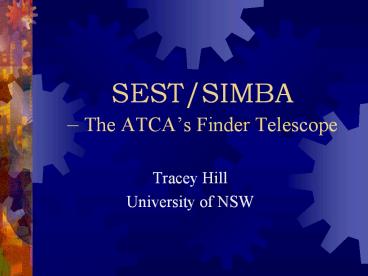SEST/SIMBA - PowerPoint PPT Presentation
Title:
SEST/SIMBA
Description:
SIMBA. 37- channel hexagonal bolometer array. Central frequency of bandpass = 250 GHz (1.2mm) ... Observing with SEST/SIMBA. On-the-fly mapping. Scanning speed: ... – PowerPoint PPT presentation
Number of Views:34
Avg rating:3.0/5.0
Title: SEST/SIMBA
1
SEST/SIMBA The ATCAs Finder Telescope
- Tracey Hill
- University of NSW
2
SEST
- 15m diameter radio telescope.
- Operates in freq range 80-
- 365 GHz.
- Currently the only large
- sub-mm telescope in the Sthn
- Hemisphere.
- Fixed secondary mirror.
3
SIMBA
- 37- channel hexagonal bolometer array.
- Central frequency of bandpass 250 GHz (1.2mm).
- The HPBW of a single element is 23",
separation between elements on the sky is 44". - Receiver operating temperature 0.3K.
- Cooled with liquid Helium and Nitrogen.
- Range of scan speeds and map sizes.
- On-the-fly mapping (chopping done in electronics).
4
Observing with SEST/SIMBA
- On-the-fly mapping.
- Scanning speed 8 per second.
- Map size 480 x 240.
- Mapped each source for 4 minutes each.
- Mapped each source 3 times.
- Data reduction produces individual images, which
you can coadd together. - Noise level of 90mJy (after 3 maps).
- Observed 120 maps - most have gt2 sources.
5
G291.27-0.70
- Flux 68.7Jy, Mass 15, 300M?
6
G18.30-0.39
- Flux 5.6Jy, Mass 850M?
7
G5.89-0.39
- Flux 39.8Jy, Mass 4, 900M?
8
SEST ATCA
- Using UCHII and CH3OH maser surveys, we can
detect star forming regions with SEST. - Determining the masses of the objects allows us
to infer the presence of multiple cores in our
detection. - Using ATCA we can resolve single sources into
multiple cores.
9
Potential Results with ATCA
- ATCA provides high resolution imaging of the
source. - At 3mm, the protostellar core is cold and
optically thin thus we can probe the inner parts
of the star forming complex. - Multiwavelength data gives the S.E.D.
- S.E.D gives the age of the star forming complex.
- Age allows prediction of evolutionary scenario
for massive star formation.
10
Summary
- Survey of UC HII and CH3OH masers produced many
multiple, massive cores when observed with SEST. - ATCA can be used to resolve these cores into
individual components.































